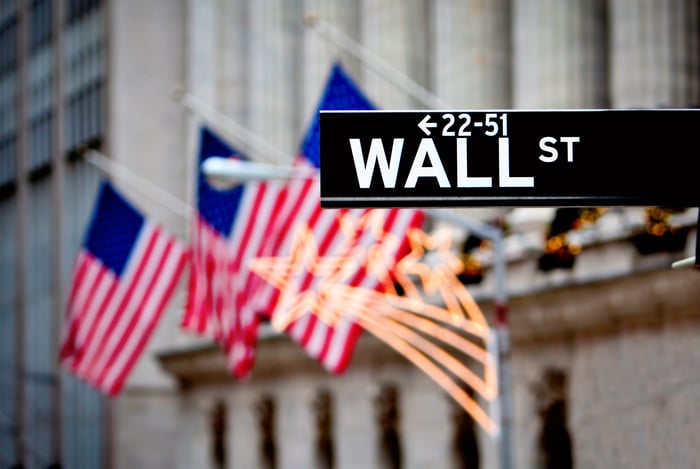The stock market has sent investors on a roller-coaster ride over the past few years. Ultra-low interest rates and pandemic-induced government stimulus sent the Nasdaq-100 technology index into rally mode during 2020 and 2021. But last year, the U.S. Federal Reserve began to aggressively tighten monetary policy, which sent the index plunging 33% for the year.
Based on historical data going back to its inception in 1986, the Nasdaq-100 rarely falls in consecutive years. True to form, it has bounced back with a 39% gain year to date. With just three months remaining in the year, it's a good time to look ahead to 2024 and assess what could be in store for the market.
Historical data can offer useful hints about how the Nasdaq-100 will perform next year, and the picture looks very positive. I'll break it down below.

Image source: Getty Images.
The Nasdaq-100 is led by some of the world's largest technology companies
The Nasdaq-100 is made up of 100 of the largest non-financial companies listed on the Nasdaq stock exchange. However, there are actually 101 equity securities in the index because it includes both Class A and Class C shares of Google parent Alphabet.
One of the most popular ways for investors to gain exposure to the Nasdaq-100 is through the Invesco QQQ Exchange Traded Fund (QQQ -1.89%), which tracks the index. Since the technology sector is very top-heavy, a small number of companies have an outsized influence on the index (and the QQQ ETF) overall. In fact, the top 5 of the 101 stock holdings account for almost 34% of its weight.
Apple, with a $2.7 trillion market capitalization, is the world's largest company. As a result, it's no surprise it's the top holding in the index. Microsoft sits in the second spot, and the top five is rounded out by Amazon, Nvidia, and Meta Platforms.
The first four of those companies are worth $1 trillion or more, with Meta not far behind. They're also some of the top-performing stocks in 2023. Apple is the laggard of the bunch with a year-to-date gain of 35%, while Nvidia leads the pack after gaining a whopping 200% so far.
The weighting of the Nasdaq-100 toward those high-flying tech giants is the reason it has more than doubled the 16% gain of the benchmark S&P 500 index this year, which has a far more diverse composition.
Here's how the Nasdaq-100 could perform in 2024, according to historical data
Where the Nasdaq-100 index eventually closes 2023 could have an impact on its performance in 2024, at least according to historical data going back to 1986.
Years in which the index has achieved a gain of 40% (or more) are almost always followed by further gains the following year, with the exception of 1999, which preceded the burst of the dot-com bubble:
|
Year |
Nasdaq-100 Gain |
Nasdaq-100 Gain (Loss) the Following Year |
|---|---|---|
|
1991 |
64.9% |
8.8% |
|
1995 |
42.2% |
42.2% |
|
1996 |
42.2% |
20.6% |
|
1998 |
85.3% |
101.9% |
|
1999 |
101.9% |
(36.8%) |
|
2003 |
49.1% |
10.4% |
|
2009 |
53.5% |
19.2% |
|
2020 |
47.5% |
26.6% |
|
2023 YTD |
42.5% |
??? |
Data source: Slickcharts. Table by author. YTD = year to date.
That means if the Nasdaq-100 holds its current gains for 2023 -- or adds to them -- there's a possibility it could further rise in 2024 with an average gain of 24.1% based on the above data.
Of course, history alone shouldn't be the reason investors buy stocks. Several factors could swing the market one way or the other next year, and interest rates might be at the top of that list. Most economists believe the U.S. Federal Reserve has almost done enough to cure America's inflation challenges, but there is a small probability of one more interest rate hike in November.
Attention will soon turn to interest rate cuts instead, which could begin in June 2024, according to current estimates. If that happens, more investors will likely turn to stocks as they hunt for higher returns, and companies will be able to borrow money at cheaper interest rates to fuel growth. Both of those things are tailwinds for the broader market.
However, if rates remain higher for longer -- or worse, the Fed increases them more than expected -- the reverse could happen, which will create a headwind for the stock market.
In any case, prior trends point to another good year for the tech index. But the long-term picture is even more exciting because companies like Nvidia continue to work on innovative new technologies like artificial intelligence. Through that lens, there is never a bad time to buy a growth index like the Nasdaq-100 so long as you're willing to hold for a period of at least five years.





